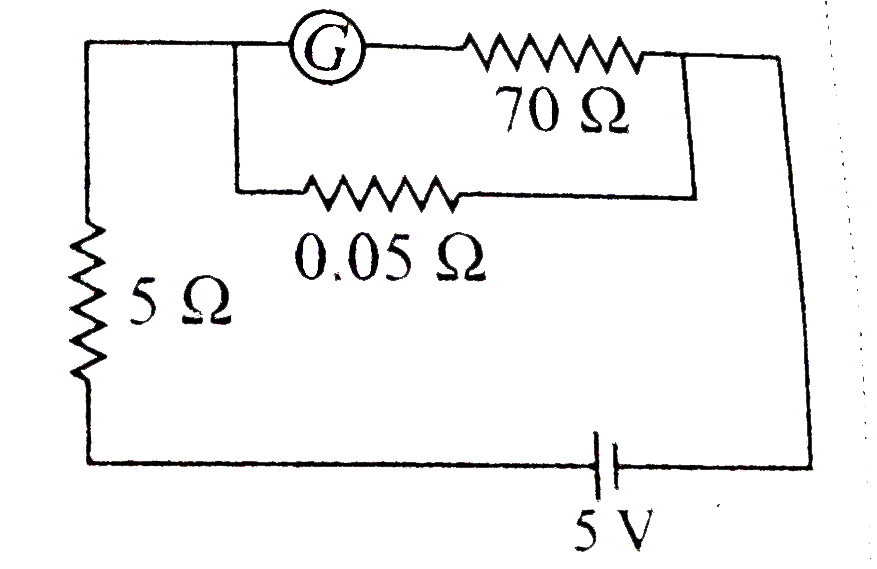A 50Ω resistance is connected to a battery of 5 V. A galvanometer of resistance 100Ω is to be used as an ammeter to measure current through the resistance, for this a resistancer rs is connected to the galvanometer. Which of the following connections should be employed if the measured current is within 1% of the current without the ammeter in the circuit?
rs=0.5Ω in parallel with the galvanometer
rs=0.5Ω in series with the galvanometer
rs=1Ω in series with galvanometer
rs=1Ω in parallel with galvanometer
The correct Answer is:a
When there is no ammeter in the circuit, then current can be written as follows:
I=VR=550=0.1A.
When ammeter is added in the circuit then current of the circuit decreases and it is given that current should not change by more than 1%. Hence current in the circuit when ammeter is included can be written as
I.=0.099A
Small variation in current is possible only when effective resistance of the galvanometer is minimum, So we should connect resistance S in parallel to the galvanometer.
Effective resistance of the circuit can be written as follows:
Reff=50+100S100+S=VI.
⇒100S100+S=50.099−50=50.50−50
⇒100S100+S=50.099−50=50.50−50=0.5
⇒100S−0.5(100+S)
⇒100S=50+0.5S
⇒S=0.5Ω
Hence 0.5Ω resistance should be connected in parallel to the coil of galvanometer. Hence option (a) is correct.
Topper's Solved these Questions
- MOVING CHARGES AND MAGNETISMBOOK - MODERN PUBLICATIONCHAPTER - MOVING CHARGES AND MAGNETISMEXERCISE - COMPETITION FILE (C. MULTIPLE CHOICE QUESTIONS)
28 Videos
- MOVING CHARGES AND MAGNETISMBOOK - MODERN PUBLICATIONCHAPTER - MOVING CHARGES AND MAGNETISMEXERCISE - COMPETITION FILE (D. MULTIPLE CHOICE QUESTIONS)
10 Videos
- MOVING CHARGES AND MAGNETISMBOOK - MODERN PUBLICATIONCHAPTER - MOVING CHARGES AND MAGNETISMEXERCISE - COMPETITION FILE (A. MULTIPLE CHOICE QUESTIONS)
38 Videos
- MAGNETISM AND MATTERBOOK - MODERN PUBLICATIONCHAPTER - MAGNETISM AND MATTEREXERCISE - CHAPTER PRACTICE TEST FOR BOARD EXAMINATION
16 Videos
- NUCLEIBOOK - MODERN PUBLICATIONCHAPTER - NUCLEIEXERCISE - CHAPTER PRACTICE TEST FOR BOARD EXAMINATION
15 Videos
Similar Questions
A galvanometer of resistance 1000Ω gives full-scale deflection for a current of 1mA. To measure a P.D of 10V, the resistance to be connected with the galvanometer is
View SolutionIn a galvanometer 5% of the total current in the circuit passes through it. If the resistance of the galvanometer is G, the shunt resistance 'S' connected to the galvanometer is
View Solution
Knowledge Check
In an ammeter 5% of the main current is passing through the galvanometer. If the resistance of galvanometer is G, then the resistance of shunt S will be
A19GBG/19C20GDG/20W
A19GBG/19C20GDG/20When a battery of emf 2 V is directly connected to a galvanometer of resistance 100Ω. It shows full scale deflection. To measure 1 A current , the shunt must be
A4910ΩB1049ΩC10049ΩD49100Ω
The resistance of galvanometer is 999Ω. A shunt of 1Ω is connected to it.If the main current current is 10−2A, what is the current flowing through the galvanometer .
View SolutionIn the given circuit, a galvanometer with a resistance of 70Ω is converted to an ammeter 0.05Ω by a shunt resistance of 0.05 2, total current measured by this device

View SolutionA galvanometer of resistance 100Ω gives the full scale deflection for a current of 10 m A. If a resistance of 1Ω is connected in parallel to the coil of the galvanometer , then maximum current that can be measured with the galvanometer will be
View SolutionIn a galvanometer, 5% of the total current in the circuit passes through it. if the resistance of galvanometer is G, the shunt resistance S connected to galvanometer is
View SolutionA galvanometer of resistance 10kΩ can measure a maximum current 1 mA. A non-ideal battery of emf 6 V is connected across this galvanometer. A resistance 1Ω is also connected across the galvanometer. If the galvanometer reads a current 0.2 mA, the internal resistance of the battery is:
View Solution
